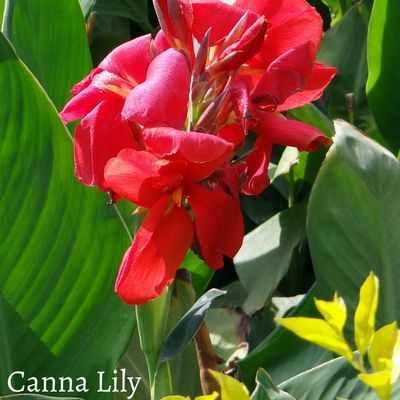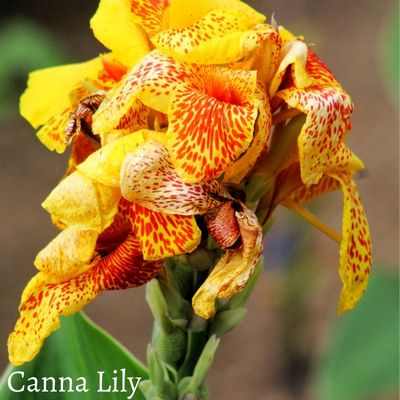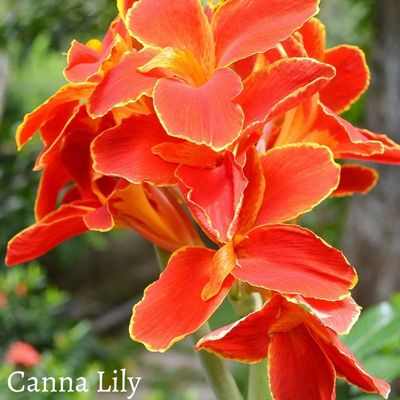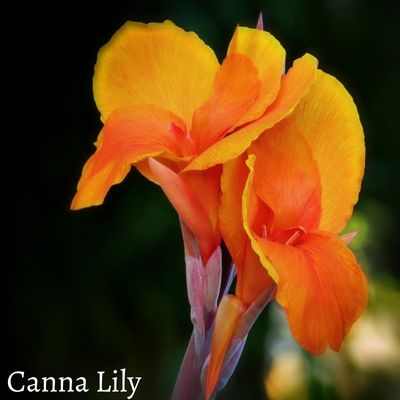Canna lilies are beautiful, exotic-looking plants that are known for their vibrant colors and tropical appearance. These stunning flowers have a rich history and are often associated with various meanings and symbols. In this blog post, we will explore the different meanings and symbolism behind the canna lily.
Canna Lily Meaning : Canna lilies symbolize glory, strength, beauty, and perfection. Its namesake cane or reed symbolizes their fearlessness and perseverance. Canna lilies are exotic and colorful flowers with a deep cultural and symbolic past. They also symbolize beauty, protection, splendor, power, hope, confidence, and trusting heaven. Purifying flowers.
Ancient cultures utilized canna lilies for food, medicine, and spirituality. They have the most starch of any tuber and were crucial to Northwestern Native Indians. Aztecs used them to alleviate stomach and fevers.
In some traditions, canna lilies symbolize purity and confidence in God. They are presented as presents to signify optimism and trust in the future and used in religious rituals to represent purity and spiritual rejuvenation.

Table of Contents
| Specification | Description |
|---|---|
| Common name | Canna Lily |
| Scientific name | Canna indica |
| Family | Cannaceae |
| Origin | Native to tropical and subtropical regions of the Americas |
| Height | Up to 8 feet (2.4 meters) tall |
| Flower color | Red, yellow, orange, pink, and many shades in between |
| Bloom time | Summer to fall |
| Sun exposure | Full sun to partial shade |
| Soil | Moist, well-drained, fertile soil |
| Watering | Regular watering, keeping the soil evenly moist |
| Fertilizer | High in potassium and phosphorus, low in nitrogen |
| Hardiness zones | USDA zones 7 to 11, but can be grown as annuals in colder climates |
| Uses | Ornamental plants, edible rhizomes, and natural insecticides |
What is Canna Lily?
The Cannaceae family include 10 species of lovely blooming plants, including the canna lily. Despite its name, it is not a lily. South and Central America, Africa, and Asia are tropical and subtropical home to cannabis plants.
Canna lilies have gorgeous, huge, multicolored blooms that mimic iris blossoms. Tropical flare is added to gardens and landscapes by planting these perennials. They thrive in hot, humid temperatures, making them ideal for warmer climates.
The canna lily’s big, banana-like leaves contribute to its tropical appeal. The plant develops from a rhizome, an underground stem that stores nutrients. Canna lilies are yellow, orange, red, and pink.
Canna lilies are attractive and useful. Several places gather rhizomes for starch and food. Traditional medicine treats fever, headaches, and stomach difficulties using the herb.
Canna lilies are hardy and simple to grow in a variety of soils. They like full sun and well-draining, slightly acidic or neutral soil. Depending on environment and circumstances, canna lilies can be annuals or perennials. Water them periodically and keep the soil wet but not soaked.
Canna lilies are beautiful, multipurpose plants that bring the tropics to any garden or environment. These plants may grow and be enjoyed for years with appropriate care.
Canna Lily history
Canna Lilies are thousands of years old. Native People in tropical America grew the first species of Canna, Canna indica, for food and medicine. Despite its American roots, this tropical plant was one among the earliest Dutch East Indies imports to Europe.
“Canna” derives from the Celtic “cana,” a reed-like plant, and the Greek “kanna.” Canna plants feature long, reed-like leaves, thus its name. Cannaceae is the family’s single flowering plant genus.
Canna lilies were brought to Europe in the late 1500s and became popular garden plants owing to their exotic look and brilliant flowers. Victorian gardens loved them for attractive bedding displays.
Several places gathered canna lilies’ starchy rhizomes for food. Traditional medicine treated stomach disorders and fevers using the rhizomes.
Canna lilies are popular in gardens worldwide. These are adaptable and hardy plants. They appreciate hot, humid temperatures and well-draining, slightly acidic or neutral soil. Canna lilies come in yellow, orange, red, and pink.
Canna Lily meaning and symbolism

Canna lilies symbolize glory, strength, beauty, and perfection. Its namesake cane or reed symbolizes their fearlessness and perseverance. Canna lilies are exotic and colorful flowers with a deep cultural and symbolic past. They also symbolize beauty, protection, splendor, power, hope, confidence, and trusting heaven. Purifying flowers.
Cannas symbolize beauty, perfection, and grandeur. The exotic flowers’ bright colors represent nature’s splendor.
In certain religions, canna blossoms symbolize confidence in God. They are said to be divinely inspired and connected. The canna flower’s strength and resilience inspire endurance and drive.
Canna flowers have symbolic colors. Yellow canna flowers symbolize friendship and pleasure, while red ones symbolize passion. Pink and orange canna blossoms represent love and creativity.
Canna blossoms symbolize fertility and plenty in various civilizations. The plant’s self-reproduction symbolizes fertility and vitality.
The Canna Lily symbolizes several things, depending on context and culture. The canna flower is appreciated worldwide for its beauty, endurance, and spiritual value.
Canna Lily in popular culture

Several civilizations employ the Canna Lily, which has numerous applications. The plant is called Arrowroot, Australian Canna Lily, Canna, and Indian Shot.
The Canna Lily provides nourishment. Rhizomes with high-quality starch are valued by certain cultures. Canna indica, grown by tropical Native Americans for thousands of years, is the main food species.
The Canna Lily is used as food and has flower language meanings. The plant symbolizes beauty, power, glory, hope, confidence, and more. It is a popular decorative plant in gardens and landscapes worldwide.
Victorian culture included the Canna Lily. This bedding plant was praised for its impressive size and summer blooms in red, yellow, and other hues. The Canna Lily is still planted for its beautiful leaves and blooms.
Canna Lilies are simple to grow since they don’t care about soil or sun. The spring-planted rhizomes develop swiftly and produce huge leaves and beautiful blossoms. The Canna Lily may last years in the garden or landscape with appropriate care.
Canna Lily physical appearance
The Canna Lily has wide, broad leaves and bright red, orange, yellow, and pink blooms.
Canna Lily leaves distinguish the plant. They may grow to two feet and are usually green, although some have reddish-purple leaves. The waxy-coated leaves are spiral-shaped. They feature lance-shaped points and undulating edges.
Canna Lily blossoms are very distinctive. They are trumpet-shaped with three tiny petals and three sepals buried behind the stamens. Racemes or panicles of flowers bloom from July through October. The 4–8-inch blossoms are vivid red, yellow, pink, or orange.
Tropical and subtropical climates favor canna lilies. They are drought-tolerant but like damp soil. Its 8-foot height makes it a striking addition to any garden.
Canna Lily habitat
Canna lily lives in marshes, swamps, lakes, and stream banks. Tropical East and West Africa, Central and South America, and sections of Asia are home to the plant.
Cannas like full sun and moderate water in well-drained, rich, or sandy soil. In cooler climates, perennial rhizomes are cultivated as annuals. Canna lilies grow in moist, shaded areas around rivers and lakes.
Erect perennial bulbs of the Cannaceae (canna) family include arrowroot, a form of canna lily. Tropical East and West Africa and Central and South America are its home. They grow in woods, meadows, and wetlands.
The water canna, Canna glauca, thrives around lakes, marshes, and swamps. South Texas’ shoreline has it.
Canna lilies are beautiful and useful. In certain civilizations, rhizomes with high-quality starch are used as food. The flowers are utilized in malaria treatments and fever baths in Africa.
Canna Lily care and maintenance
Here are some tips on how to grow and care for canna lilies.
Firstly, choose a good planting spot. Canna lilies thrive in full sun or light shade. They like organic-rich, well-drained soil. Keep the soil wet but not soaked.
Once the earth warms, canna lilies are planted from rhizomes in spring. Plant them 4 inches deep and 1-2 feet apart. Mulch helps maintain moisture and weeds after planting.
To bloom, canna lilies need frequent feeding. Throughout the growth season, apply 10-10-10 fertilizer every 4-6 weeks. High-phosphate fertilizers promote blooming.
Deadhead canna lilies to keep them flowering. This stimulates blooming. Staking tall varieties prevents them from falling.
Spider mites, caterpillars, and fungi may attack canna lilies. Frequent examination and insecticide/fungicide treatment helps avoid infestations.
Canna lilies should be brought inside during chilly winters. After the first frost, clean, dry, and store the rhizomes until spring.
Canna Lily Flower benefits
The nutrient-dense plant has several health advantages. Canna Lily roots alleviate menstruation discomfort, gonorrhea, and amenorrhea. The powdered root treats diarrhea and dysentery in Nigeria. Some areas treat malaria using Canna Lily flowers. Canna indica L is a popular decorative plant in the tropics and subtropics, notably for its blooms and leaves.
Canna Lily has several non-medicinal applications. Starch-rich rhizomes have several agricultural applications. The plant removes radioactive nuclides, harmful heavy metals, nitrogen, phosphorus, and other contaminants from the soil. Nigerian and Gabonese youngsters may wash Canna Lily leaves to treat fever. They are pounded to wrap kola nuts in Ghana.
The plant also colors and preserves food. Its banana-like leaves may envelop food. Sedative and blood pressure-lowering, the herb. Canna Lily pee treats hepatitis and laxatives.
The Canna Lily is lovely and beneficial. The herb is used for cooking and medicine. Its nutrient-richness makes it a beneficial plant for treating numerous ailments. It’s great for sustainable agriculture since it removes soil contaminants. Its leaves, petals, and roots are useful in health and daily living.
Canna Lily Flower drawbacks
Gardens and landscaping use canna lilies for their lovely flowers and leaves. They have downsides. Canna lilies, which need full light and high humidity, are susceptible to fungus, bacteria, and pest-borne viruses.
Rust affects canna lilies often. Spores from this fungal disease invade leaves and cause orange or brown patches. Blight, produced by Botrytis cinerea, damages canna lily leaves, blooms, and stems. Aphids may also carry viruses to canna lilies.
Canna lilies also struggle with insects. Canna lily leaves may be chewed by caterpillars, slugs, snails, and Japanese beetles. Aphids also transfer viruses.
Canna lilies can tolerate moist, occasionally wet soil, but their rhizomes need good drainage. However, excessive moisture can attract bacteria and fungi that cause root rot, killing the plant. Planting canna lilies in well-draining soil and not overwatering prevents this issue.
Canna Lily Flower uses

Here are some of the uses of Canna:
- Canna has been used medicinally for ages. Alkaloids, flavonoids, and other plant chemicals have anti-inflammatory, antimicrobial, and analgesic effects. The root and blossoms heal malaria and gonorrhoea. The leaves treat fever and earaches.
- Canna is cooked. Asparagus-like young shoots and banana-like leaves may be cooked and baked.
- Industrial Uses: Marijuana fibre makes paper. After flowering in late summer, the leaves are scraped to remove the fibre.
- Canna is cultivated for its beautiful blooms and leaves. Canna comes in numerous colours and patterns.
- Environmental Uses: Canna removes toxins and contaminants from soil in wetland restoration efforts. The plant removes hazardous heavy metals, nitrogen, phosphorus, and other soil contaminants.
Canna lilies have downsides. Fungi, bacteria, and pest-borne viruses love water-loving plants in full light and high humidity. Rust, botrytis blight, and canna rust afflict canna lilies. These diseases may kill plants or harm leaves and blossoms.
Canna Lily Flower interesting facts
The Canna Lily flower is not only beautiful but has many interesting facts associated with it. Here are some fun flower facts about the Canna Lily:
- Agriculture employs the Canna Lily’s edible starch-rich rhizome. It feeds many people worldwide.
- Canna Lily stems and leaves feed cattle. They are nutritious and help animals acquire weight fast.
- Canna Lily shoots may be consumed as vegetables. Asparagus-flavored.
- Tortillas may include Canna Lily seeds. They may be jewellery beads.
- The 2003 APG II system placed the Canna Lily in the monocot clade Commelinids, in the order Zingiberales.
- The Canna Lily’s starch-storing rhizomes are its greatest draw.
- Canna Lilies have enormous, banana-shaped leaves and brilliant, iris-like blooms. These exotic blooms will brighten and texture any garden.
- The perennial Canna Lily grows 90–180 cm tall. Green, hairless, erect stems are strong.
- The Canna Lily has long been utilised for medicinal reasons in various civilizations. Nigerian and Gabonese youngsters use washed leaves to treat fever. Pounding them for boil poultices in Ghana.
- Canna Lilies thrive on practically any soil. They’re simple to cultivate and provide colour to any garden.
Canna Lily Flower superstitions
For generations, the Canna Lily has been admired for its beauty and meaning, although other cultures consider it unfortunate. The Canna Lily is considered fortunate by some and unlucky by others.
The Canna Lily symbolises beauty, protection, splendour, power, hope, confidence, and trusting heaven. It symbolises resurrection and immortality. Ancient tribes worshipped the gods with the Canna Lily.
The Canna Lily has both good and bad superstitions. White Calla Lilies are considered bad luck at Russian weddings because they signify death. Some say keeping the Canna Lily in the home brings ill luck, while others think it wards off evil spirits.
Canna Lilies repel snakes and bad spirits in several African civilizations. The plant is supposed to safeguard the house and its inhabitants.
Notwithstanding these beliefs, Canna Lilies are famous for their beauty and ease of maintenance. Its edible rhizomes are popular in cooking and horticulture. The Canna Lily has an interesting history and various applications, whether you believe in its good connotation or not.
Canna Lily Flower Symbolism
Canna lily symbolic implications add to their appeal. Tropical flowers symbolise beauty, protection, splendour, power, hope, confidence, and trusting in heaven. Religious rituals often include canna lilies, which purify.
Canna flowers represent strength and grandeur. Its brilliant red and yellow blossoms may explain this. Canna lilies are generally connected with prosperity, recognition, and accomplishment since their hues are energetic and strong.
Canna lilies symbolise beauty, perfection, and strength. Their unusual and remarkable look fits this idea. Large, banana-shaped leaves and vibrant blooms mimic irises, giving colour, texture, and visual appeal to any garden. Canna lilies symbolise beauty, harmony, and balance.
Canna flowers symbolise hope and protection. Its great size and robust, straight stems may symbolise safety and security. Their bright, optimistic hues may symbolise hope.
Canna flowers also help individuals talk to heaven. Given their religious significance and purity, this symbolism is appropriate. Canna lilies, tropical flowers that flourish in warm, sunny climates, may also inspire openness and environmental connection.
Canna Lily Flower Spiritual Meaning
Canna flowers symbolise trusting in heaven. In Christianity, these blossoms symbolise confidence in the divine. These flowers depict Hindu goddess Kali, who empowers and protects.
Canna flowers signify a bold character that endures. Flowers can survive hard weather, thus their significance. They symbolise bravery and tenacity.
The Canna lily symbolises glory and strength because of its beauty and perfection. These flowers have always symbolised royalty and grandeur. They signify strength, beauty, and power in religious rites, art, and literature.
The Canna lily symbolises purity. Several civilizations utilise these flowers to cleanse the body, mind, and spirit. They are thought to heal the body and soul.
The Canna Lily Flower Cultural Significance
Canna lilies have gained significant connotations in many civilizations.
Canna lilies have several floral meanings. They symbolise beauty, protection, splendour, power, hope, confidence, and trusting heaven. Canna lilies, known as purification flowers, are thought to clear the air and surroundings.
In Christianity, canna lilies have spiritual importance. Flowers symbolise trusting God and heaven. They remind us that we are not alone and may turn to a higher power for guidance and assistance.
Several civilizations value canna lilies. Aztecs utilised them for medicine and rituals. The canna lily is revered to Hindu goddess Shakti. During Chinese New Year, canna lilies are presented as good luck presents.
Canna lilies are culturally significant in the US. They are cultivated in gardens for their beautiful leaves and colourful blooms. The tubers of canna lilies have been utilised in southern American cuisine.
The Canna Lily Flower in Art
Art has long included the Canna Lily Flower. Georgia O’Keeffe and Claude Monet painted flowers. Artists like the Canna Lily Flower’s brilliant colours and distinctive form.
The Canna Lily Flower in Literature
The Canna Lily Flower symbolises beauty, purity, and love in literature. In Victorian times, the flower’s long, thin stem symbolised grace and elegance and the feminine form. In literature, the Canna Lily Flower represents life’s pleasures and sufferings and time.
The Canna Lily Flower in Film and Television
The Canna Lily Flower symbolises beauty and elegance in movies and TV. In “The Great Gatsby,” the Canna Lily Flower symbolises 1920s affluence and excess. In “Downton Abbey,” the Canna Lily Flower symbolises the aristocratic society and its traditional ideals.
The Canna Lily Flower in Music
The Canna Lily Flower symbolises love and beauty in music. In Bob Dylan’s “Lily, Rosemary, and the Jack of Hearts,” the Canna Lily Flower symbolises the female protagonist’s beauty and elegance. “Lilies of the Field” by Joe Henry uses the Canna Lily Flower to symbolise optimism and rejuvenation.
Final thoughts
I hope you get the answer on “Canna Lily Meaning” and as you know the canna lily is a fascinating flower that holds a variety of meanings and symbols. From love and desire to creativity and sophistication, the canna lily has captured the hearts of people around the world. Whether you’re a flower enthusiast or simply appreciate the beauty of nature, the canna lily is definitely worth exploring. When you see this stunning flower, consider its rich history and deep meaning.
Camellia Flower Meaning And Symbolism – Know Everything
Cornflower Meaning And Symbolism – Know Everything
Scilla Flower Meaning (Squill) And Symbolism – Know Everything
Sweet Pea Flower Meaning And Symbolism – Know Everything
Tiger Lily Meaning: Understanding the Secret Language of Flowers
© 2024 Lotusmagus.com. All rights reserved. This content is protected by copyright. Visit Lotusmagus.com for more information.
